Lombardy is located in northern Italy and is known for its beauty, culture, cuisine, and many attractions. It has several nicknames like “The Industrial Heart of Italy” due to its prosperous economy. Lombardy is situated between the Alps and Po Valley at 45°35′N 9°55′E. It borders Switzerland plus the Italian regions of Piedmont, Emilia-Romagna, Veneto, and Trentino-Alto Adige. The current president of Lombardy in 2023 is Attilio Fontana.
The region has many lakes, including Lake Como, Lake Garda, and Lake Maggiore. Famous mountain ranges include the Bergamo Alps and the Lepontine Alps. Several UNESCO sites like the Rock Drawings in Valcamonica and The Last Supper painting by Leonardo da Vinci also exist. Museums are scattered throughout cities like Milan and Mantua.
The capital and largest city of Lombardy is Milan, sometimes called the “moral capital” of Italy. Other major cities are Bergamo, Brescia, Como, Cremona, Lecco, Lodi, Mantua, Monza, Pavia, Sondrio, and Varese. Lombardy offers natural beauty, history, culture, food and fashion.
Where is Lombardy Located?
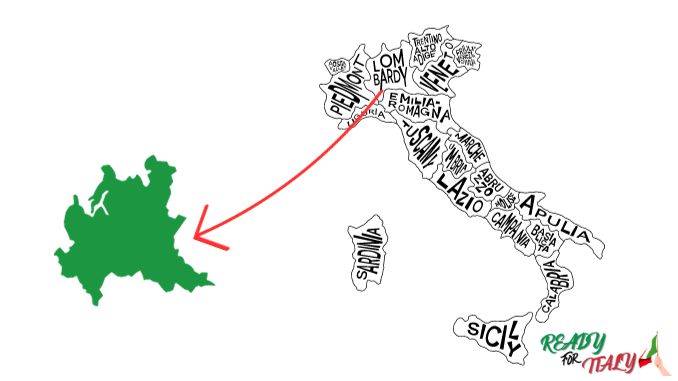
Lombardy stretches about 100 miles west of Venice in northern Italy. It extends from the Alps down to the Po Valley basin. Lombardy borders Switzerland, plus the Italian regions of Piedmont, Emilia-Romagna, and Veneto.
Its central location made Lombardy influential in finance, industry, tourism, and transportation. Its proximity to the Alps also makes it popular for winter sports. The region’s connections via rail, air, and highways also make it easily accessible for domestic and international travelers. Milan, its capital, is a major global hub.
What is the Population of Lombardy?
According to 2023 estimates done by statista.com, Lombardy has a population of 9,950,742 people, making it the most populated region in Italy. The population density is 417 residents per square kilometer. Growth has slowed in recent decades, but Lombardy continues attracting immigrants and Italians from other regions due to its strong economy and abundant jobs.
Tourism is a vital industry fo Lombardy. In 2023, there were 43 million arrivals and 30.7 million hotel stays, according to the tourism department. International visitors, especially Germans, Swiss, French, and British tourists, accounted for 68% of hotel stays. Tourism employs around 193,000 people in Lombardy.
Map of Lombardy
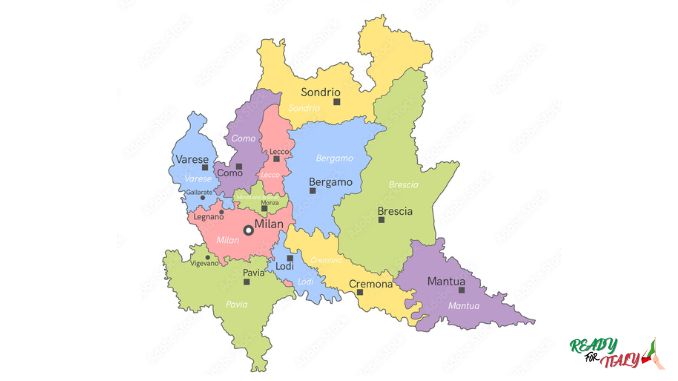
What are the Geographical Features of Lombardy?
Lombardy has varied geographical features, from mountains to plains. In the north lies part of the Alps range with peaks like Mount Legnone, Pizzo di Coca, and Monte Disgrazia. There are also pre-Alps like the Bergamasque Alps and the Ortler Alps.
South of the mountains, foothills transition into the flat Po Valley basin drained by the Po River and its tributaries. The southernmost section flattens into the Venetian Plain. Scattered throughout are scenic lakes like Como, Iseo, Garda, and Maggiore, covering over 1000 square miles of inland water area.
Several national and regional parks protect the natural landscapes, like Stelvio National Park, Adamello Regional Park, and Oltrepò Pavese Natural Park. The climate is generally humid subtropical, with warm summers and cold winters perfect for winter sports.
What are the Most Famous Lakes to Visit in Lombardy?
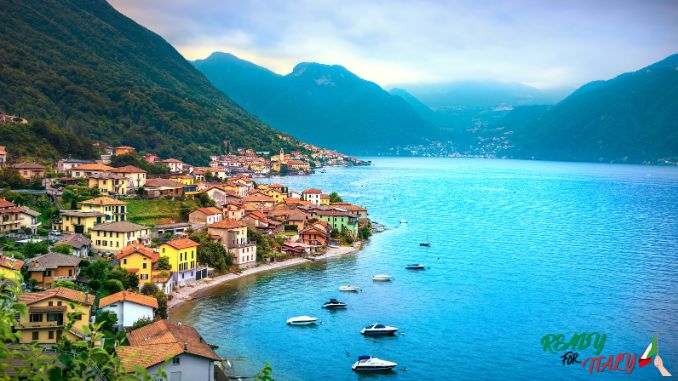
- Lake Como – This glacier lake has an inverted Y-shape, beautiful villas, villages like Bellagio and Varenna, and the city of Como. It’s a popular weekend spot for Milan residents. Activities include watersports, ferries, and hillside villages accessible by boat.
- Lake Garda – Italy’s largest lake, is known for its Mediterranean climate, mountain views, resort towns like Sirmione, and windsurfing. Attractions include Scaliger Castle, Grotte di Catullo Roman ruins, and Parco Sigurtà botanical gardens.
- Lake Maggiore – This long lake on the Lombardy and Piedmont border has elegant resorts like Stresa and enchanting Borromean Islands. Highlights include Isola Bella’s lavish Borromean Palace and gardens.
- Lake Iseo – A less touristy lake with alpine scenery and towns like fashionable Monte Isola rising from the blue waters. It is ideal for fishing, boating, and biking along the shore.
- Lake Lugano – A glacial lake bordering Switzerland and Italy, has elite resorts and magnificent views of the Alps. Known for activities like sailing, tennis, golf, hiking, and high-end shopping.
- Lake Varese – Shallow, a reedy lake close to Varese surrounded by marshy wetlands and nature reserves that attract many bird species. Popular for boating, rowing, and scenic walks.
- Lake Endine – Picturesque lake offering tranquility, birdwatching spots, and pretty views of the Prealps. The small towns along its shores are ideal for a relaxing escape.
- Lake Alserio – Small lake near Como renowned for sailing, windsurfing, and watersports. A quieter alternative to the busier neighboring Lake Como.
- Lake Pusiano – Another peaceful lake north of Como with Mediterranean charm, walking paths, and high-end villas. Known as one of the “Brianza lakes.”
- Lake Annone – A secluded lake near Lecco surrounded by mountains perfect for swimming, fishing, and boating away from tourist crowds.
What are the Most Famous Mountains to Visit in Lombardy?
- Monte Rosa Massif – Second highest mountain in the Alps on the Swiss-Italian border with excellent hiking trails and stunning Alpine views.
- Bernina Range – Dramatic sharp peaks like Piz Bernina and Piz Palü with glaciers and excellent ski areas like Valposchiavo.
- Ortler – The highest mountain in the Eastern Alps outside the Bernina Range, known for its pyramid shape and ice climbing.
- Adamello-Presanella – Impressive dolomite-like limestone range where the preserved body of Iceman Ötzi was found.
- Grignone – Prominent limestone mountain above Lake Como favored by climbers for its summit panoramas and challenging technical rock routes.
- Presolana – Distinctive mountain in the Bergamasque Prealps with cliffs, ski resorts, and extensive hiking trails.
- Monte Disgrazia – Rugged gray granite peak in the Bregaglia Range on the Swiss border, popular for climbing.
- Monte Legnone – One of the highest peaks near Lake Como, with an historic observatory at the summit.
- Monte Cadria – Lake Iseo area mountain with charming churches, ancient mining sites, and scenic walks.
- Campo dei Fiori – Pre-Alps noted for its strange rock formations, observatory, and panoramic views.
Does Lombardy Have Any UNESCO Sites?
Yes, Lombardy has several UNESCO World Heritage Sites:
- Rock Drawings in Valcamonica – 8,000-year-old prehistoric petroglyphs and rock carvings.
- The Last Supper by Leonardo da Vinci – Famous mural painting housed in Milan’s Santa Maria delle Grazie church.
- Longobards in Italy, Places of Power – Collection of 7 Lombard monuments and religious sites.
- Monte San Giorgio – Fossil-rich mountain recognized for its important paleontological record.
- Sacri Monti of Piedmont and Lombardy – Groups of religious mountainside chapels and architecture.
- Prehistoric Pile Dwellings Around the Alps – Archaeological remains of ancient stilt houses.
- Vineyard Landscape of Langhe-Roero and Monferrato – Wine region marked by castles, cellars, and unique architecture.
These demonstrate Lombardy’s natural beauty, history, and significance. The medieval towns, lake resorts, and Alpine valleys also draw UNESCO recognition.
What are the most important museums to visit in Lombardy?
- Pinacoteca di Brera – Prestigious Milan art museum with works by Raphael, Caravaggio, Piero della Francesca, and other Italian masters.
- Museo Poldi Pezzoli – Elegant private residence turned art museum in Milan with Renaissance and Baroque paintings, weaponry, ceramics, and more.
- Gallerie dell’Accademia – Venice’s foremost painting gallery displaying seminal Venetian artworks, especially from the Renaissance period.
- Cenacolo Vinciano – Milan’s Santa Maria delle Grazie convent housing Leonardo da Vinci’s masterful mural “The Last Supper.”
- Museo della Scienza e della Tecnologia – Milan museum with exhibits on science, technology, and industry, including models based on da Vinci’s designs.
- Castello Sforzesco – Imposing Milan castle with museums covering art, sculpture, furniture, musical instruments, and more.
- Villa Carlotta – Elegant lakefront estate on Lake Como housing renowned Italian sculpture and botanical gardens.
- Galleria d’Arte Moderna – Milan museum with 19th and 20th-century paintings and sculpture housed in a grand palazzo.
- Musei Civici di Como – Como’s civic museums displaying archaeology, history, art, and silk production.
- Palazzo Ducale – Grand palace in Mantua with Renaissance frescoes and the Camera degli Sposi with paintings by Andrea Mantegna.
What are the Most Famous Cities in Lombardy?
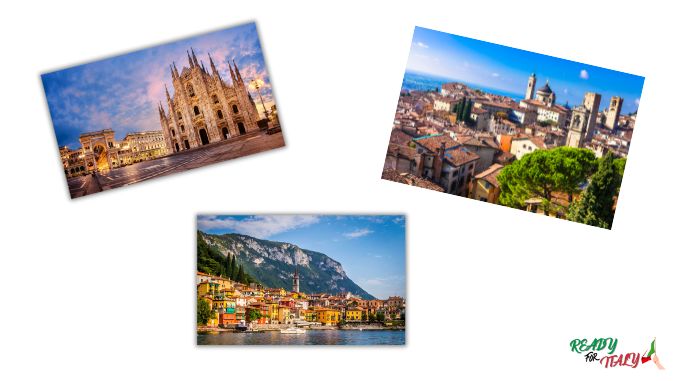
- Milan – Lombardy’s capital is Italy’s second-largest city and draws over 8 million visitors annually to see attractions like the Duomo, La Scala opera house, and Leonardo da Vinci’s “Last Supper.”
- Bergamo – Ancient city with over 1 million yearly visitors who come to explore the medieval Upper Town and Renaissance sites.
- Brescia – Over 1 million visitors annually come to the Roman ruins, castles, and Santa Giulia Museum, showcasing its history.
- Lake Como – Famed resort area including the city of Como and picturesque villages like Bellagio, Varenna and Menaggio, attracting 2.5 million visitors.
- Cremona – Birthplace of Stradivarius violins that receives half a million visitors yearly to sites like the Duomo, Torrazzo tower, and museums.
- Mantua – Atmospheric Renaissance city rich in art and architecture, enticing 300,000 visitors annually.
- Sirmione – Charming Lake Garda village with 700,000 annual visitors coming for the stunning lakefront views and historical sites.
- Varenna – Attractive Lake Como village known for its mountain vistas, winding alleyways, and lakeside promenade, attracting 100,000+ visitors per year.
- Desenzano – Lively Lake Garda harbor town and yachting center drawing 400,000+ tourists annually to its vibrant boardwalk and medieval castle ruins.
- Pavia – Historic university city featuring the famous Certosa di Pavia monastery, attracting 150,000+ visitors.
Milan
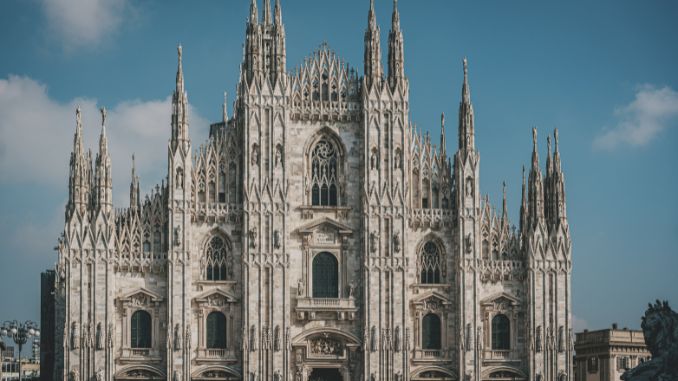
Milan is Lombardy’s capital and Italy’s second-largest city, with an estimated 3,154,570 residents. It is a global fashion and design capital and a major financial and commercial hub. Milan saw almost 6.6 million international visitors in 2022 according to statista.com.
Major attractions include the Milan Cathedral, one of the world’s largest Gothic cathedrals, as well as Leonardo da Vinci’s “Last Supper” fresco housed in the Santa Maria delle Grazie Church. Other top sites are the Sforza Castle, La Scala Opera House, Galleria Vittorio Emanuele II shopping arcade, Pinacoteca di Brera art gallery, the high-fashion Quadrilatero d’Oro district and Navigli nightlife district. It will host the 2026 Winter Olympics.
Brescia
Brescia is a city in central Lombardy with around 492,115. residents. Its historic center is a UNESCO World Heritage Site. About 3.2 million tourists visit Brescia annually.
Major landmarks include the Piazza della Loggia, the medieval Old Cathedral, the Renaissance-era New Cathedral, the imposing Castle of Brescia, and the extensive Roman ruins and museums of the San Salvatore-Santa Giulia complex. The city also holds the famous Mille Miglia classic car race every year.
Monza
Monza is a city northeast of Milan known for its Formula One racetrack, the Autodromo Nazionale Monza. It receives around 1 million visitors annually. Other attractions include the Late Gothic Duomo di Monza, the 12th-century Monza Park containing the opulent Royal Villa of Monza, as well as elegant villas constructed by Milanese aristocrats. The exciting Italian Grand Prix takes place at the race track every year.
Bergamo
Bergamo is a city northeast of Milan with about 909,262 residents. Over 1.2 million tourists visit annually to explore its medieval and Renaissance treasures.
Bergamo’s main appeal is its postcard-perfect Città Alta, or Upper Town, encircled by Venetian walls and filled with architectural gems like the Romanesque-Gothic Basilica di Santa Maria Maggiore and elegant Renaissance sites like the Cappella Colleoni. The vibrant Lower Town called Città Bassa features lovely piazzas lined with shops and cafes.
Como
Como is a city with an estimated population of 488,651 and is on the southwestern shore of Lake Como. It welcomes around 300,000 visitors annually. Top attractions include its pedestrian historic core in the Old Town, elegant Broletto town hall, the ornate Gothic Como Cathedral, and Volta Temple museum honoring hometown scientist Alessandro Volta. Como also offers easy access to Lake Como ferries and boats, providing connections to charming villages like Bellagio, Varenna, and Tremezzo.
Busto Arsizio
Busto Arsizio is a city of 663,690 residents northwest of Milan. Its historic heart contains the monumental Santi Apostoli e Nazaro Cathedral and neoclassical Villa Ottolini Tosi, now home to the city’s museums. The Museum of Textiles showcases Busto Arsizio’s history as a center of cotton production and manufacturing. Its location near Malpensa Airport also makes it an important transport hub. Around 35,000 travelers visit each year.
Sesto San Giovanni
Sesto San Giovanni, a suburb of now estimated 82,199 residents, is located northeast of Milan was a major industrial and manufacturing center in the 20th century, earning it the nickname “Stalingrad of Italy.” It has prominent socialist architectural landmarks like the Casa del Popolo community center. The Rondò Science Museum highlights its history in steel and engineering. Around 30,000 people visit annually to learn about its industrial past.
Varese
Varese is a city north of Milan with about 80,182. residents. It sees around 100,000 visitors per year who come to explore its many green spaces and architectural treasures. Top attractions include the Sacro Monte di Varese, a lush wooded hillside with chapels and shrines that is a UNESCO site. The historic center features sights like the Romanesque-style Basilica of San Vittore and elegant gardens. As an aviation hub, Varese also hosts a popular annual air show.
Cinisello Balsamo
Cinisello Balsamo is a municipality northeast of Milan near Monza and the historical Brianza region, with a 2023 population estimated at 76,827. It contains monumental churches like the Baroque Sant’Eusebio as well as modernist public art like the sculpture Il Trovatore. The Rock and Roll Hall of Fame honors famous Italian singers who lived here. Annual festivals include the Pane e Panettone, showcasing bread and sweet treats, and a short film festival. Approximately 25,000 visitors come each year.
Cremona
Cremona is a small city of 72,042 residents southeast of Milan celebrated as the birthplace of Stradivarius string instruments. About 500,000 tourists visit annually to explore its well-preserved medieval architecture. Top attractions include the Torrazzo, a 560-foot tall clocktower overlooking the central piazza, the Romanesque Cremona Cathedral with its marble façade and frescoed interior, and the museums displaying historic violins and instruments. The town is also renowned for its tradition of violin craftsmanship.
When is the Best Time to Visit Lombardy?
The best time to visit Lombardy depends on one’s interests and preferences:
- Spring (March-May) offers pleasant weather ideal for sightseeing in cities like Milan and exploring scenic spots like Lake Como as temperatures start to warm. Flowers bloom while crowds and prices remain low.
- Summer (June-August) brings hot, sunny weather perfect for boating and swimming in Lombardy’s lakes, as well as enjoying the region’s scenic parks and gardens. Many cultural events occur, too. Travel costs are higher during peak season.
- Fall (September-November) provides cooler weather suited for hiking in the Alps, wine tasting in Franciacorta vineyards, and hunting for truffles. Fall foliage creates beautiful landscapes. Crowds thin after summer, but the weather is still mild.
- Winter (December-February) allows skiing and snowboarding in mountain resorts like Livigno. The Christmas markets in cities like Mantua, Milan, and Como also come alive with holiday lights, special events, and seasonal treats.
- The shoulder seasons of spring and fall tend to have more moderate temperatures overall without intense crowds, providing a pleasant time to explore the region’s nature, cuisine, and history.
- For skiing and winter sports, December to March is ideal, with January typically being the coldest month.
- Those seeking sunshine, lake activities, and summer festivals prefer visiting between June and early September.
- Enthusiasts of local harvests and food should plan for autumn when signature products like truffles, chestnuts, and Franciacorta wine are in season.
What are the Traditional Foods of Lombardy?
Lombardy has several iconic regional dishes that visitors should sample during their stay. Some of the most popular and famous foods include:
- Risotto alla Milanese – Saffron-infused risotto originating from Milan. This creamy rice dish gets its golden hue from the precious saffron spice.
- Ossobuco – Veal shank braised with vegetables, typically served with risotto alla Milanese. It is a specialty of Milan.
- Cotoletta alla Milanese – Breaded veal cutlet fried in butter, similar to an Austrian wiener schnitzel but with Italian flair. Also found throughout Milan.
- Polenta – Creamy cornmeal porridge popular across Lombardy, either as a side dish or made into fried cakes.
- Salame di Varzi – Traditional cured sausage from the town of Varzi made with coarsely ground pork and seasoned with salt, pepper, and garlic.
- Taleggio Cheese – Semisoft washed rind cheese with a distinctive aroma and flavor, originally from Val Taleggio. Used for grating and melting.
- Panettone – Sweet yeast bread studded with raisins and citrus peel that originates from Milan and is enjoyed around Christmas.
- Torrone – Nougat confection made with egg whites, honey, and nuts – a specialty of Cremona.
- Mustard of Cremona – Spicy fruit mustard blended with herbs and often used as a dip for meats.
Visitors can find these dishes in restaurants and cafes throughout cities like Milan, Bergamo, Como, Cremona, and Brescia. Food tours are also a great way to explore Lombardy’s rich culinary traditions.
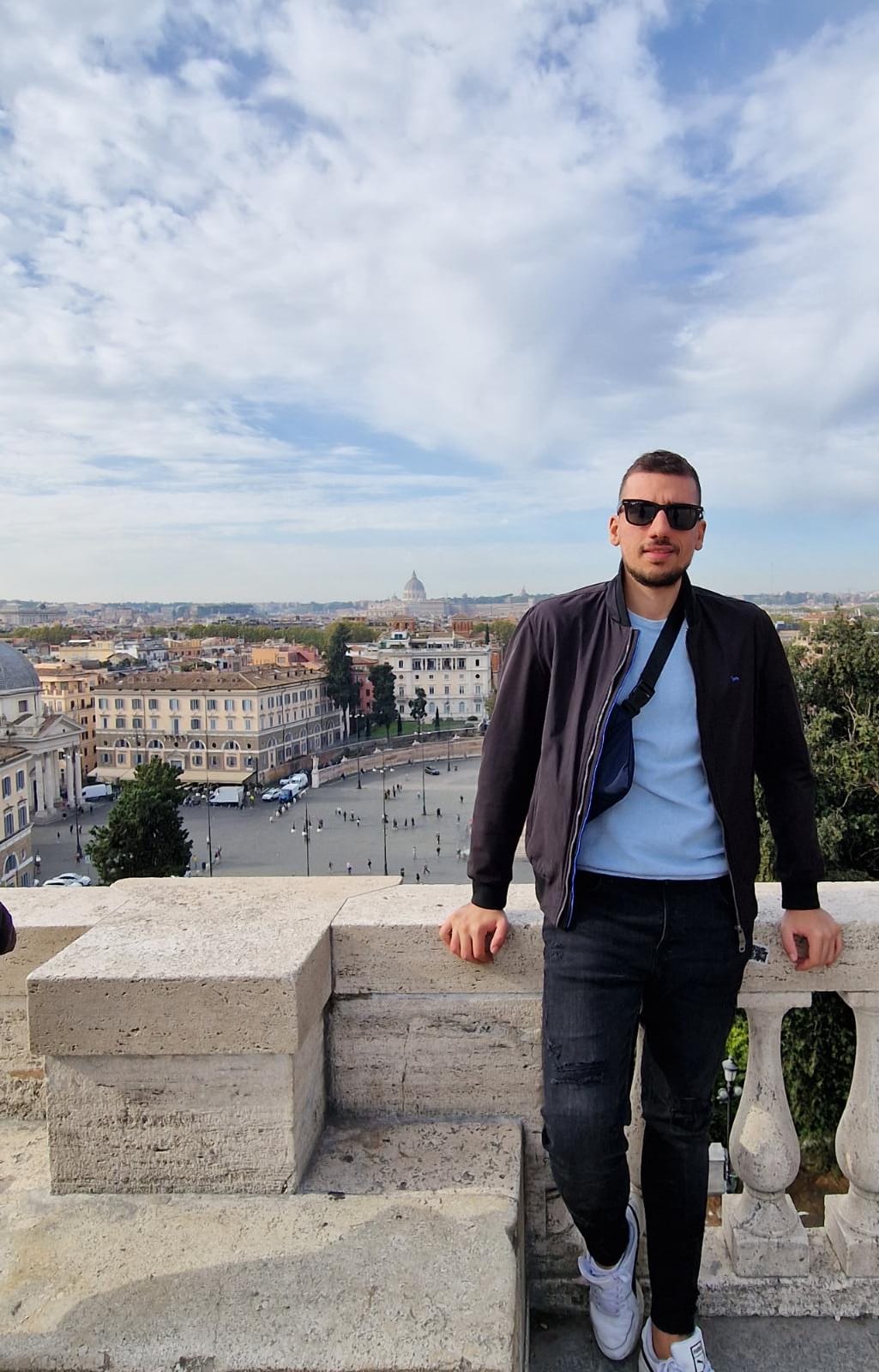
Hey, I’m Giovanni, an Italian that lives in Italy and the author of this website! I started this website because I like to travel, discover new places and share my knowledge about Italy with more people worldwide. I love writing about everything regarding Italy, its culture, history, and lifestyle. I hope you found value in whatever article you read, and if you have any remaining questions, don’t hesitate to contact me!
